ECS LIVA Q3D and ACEMAGIC T8 Plus micro-PCs Review: Jasper Lake and Alder Lake-N in a Smaller-than-UCFF Package
by Ganesh T S on September 21, 2023 9:10 AM EST- Posted in
- Systems
- Intel
- ECS
- LIVA
- Jasper Lake
- Alder Lake-N
- AceMagician
- micro-PC
System Performance: Miscellaneous Workloads
Standardized benchmarks such as UL's PCMark 10 and BAPCo's SYSmark take a holistic view of the system and process a wide range of workloads to arrive at a single score. Some systems are required to excel at specific tasks - so it is often helpful to see how a computer performs in specific scenarios such as rendering, transcoding, JavaScript execution (web browsing), etc. This section presents focused benchmark numbers for specific application scenarios.
3D Rendering - CINEBENCH R23
We use CINEBENCH R23 for 3D rendering evaluation. R23 provides two benchmark modes - single threaded and multi-threaded. Evaluation of different PC configurations in both supported modes provided us the following results.
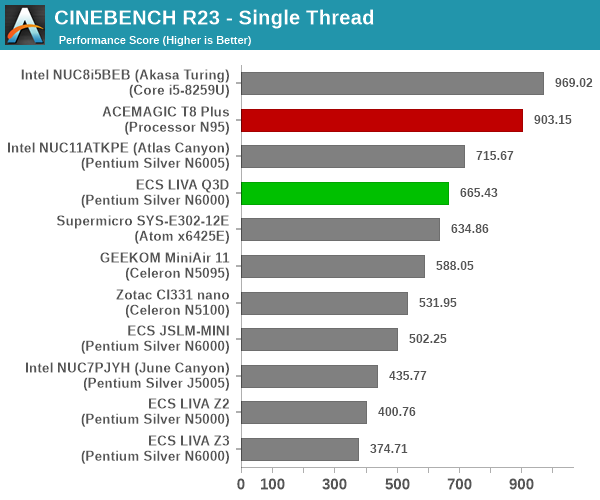
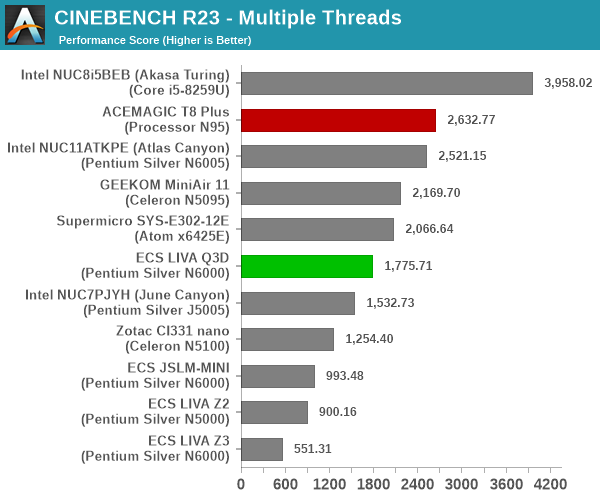
The LIVA Q3D delivers performance expected out of Jasper Lake, unlike the passively-cooled ECS LIVA Z3 which throttled heavily. However, the T8 Plus's score is the surprise package. Despite using an Atom-class microarchitecture, the performance almost reaches the levels seen in the Coffee Lake-U processors for single-threaded performance. With multiple threads in the picture, the comparison is not as rosy, but the relative ordering remains the same. The T8 Plus is well ahead of other Atom-based competitors.
Transcoding: Handbrake 1.5.1
Handbrake is one of the most user-friendly open source transcoding front-ends in the market. It allows users to opt for either software-based higher quality processing or hardware-based fast processing in their transcoding jobs. Our new test suite uses the 'Tears of Steel' 4K AVC video as input and transcodes it with a quality setting of 19 to create a 720p AVC stream and a 1080p HEVC stream.
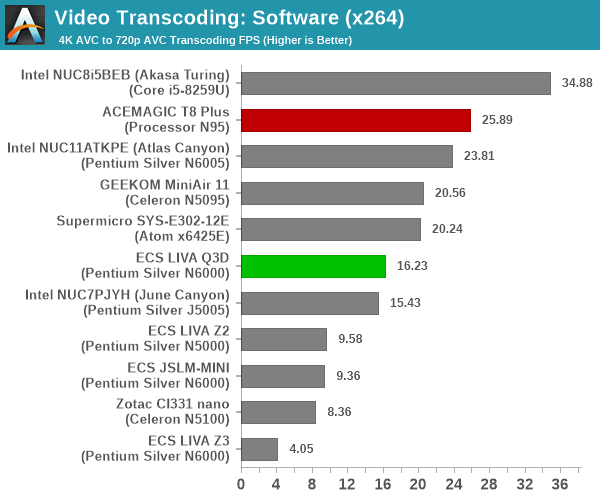

The presence of newer generation cores in the T8 Plus gives it a very good advantage for this multi-threaded benchmark. With all systems using processors with similar core counts, higher power budget translates to higher performance. The 15W configuration of the Intel Processor N95 (compared to the 6W / 10W ones in other systems using a similar class of processors) is the deciding factor in this benchmark.
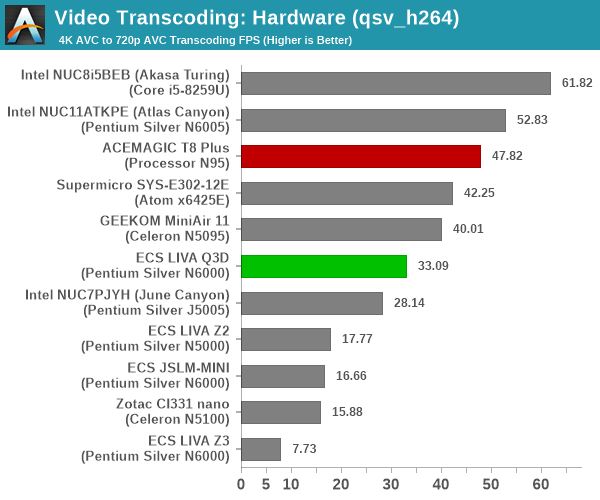
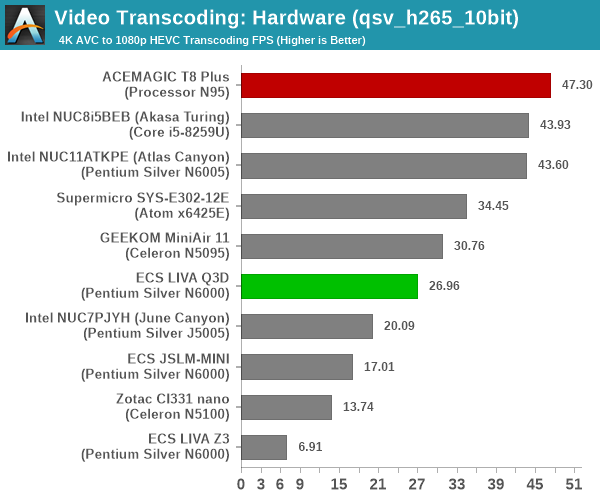
Hardware-accelerated transcoding rates are a function of GPU clock rates and power budget. While the clock rate advantage is evident in the H265 benchmark, the Atlas Canyon NUC surpasses the T8 Plus in the H264 one. A reason for this could be the 25W PL2 that may allow the QuickSync engine to run faster. It is possible that improvements to the engine for H265 in the newer processor may contribute to its leading performance for that codec.
Archiving: 7-Zip 21.7
The 7-Zip benchmark is carried over from our previous test suite with an update to the latest version of the open source compression / decompression software.
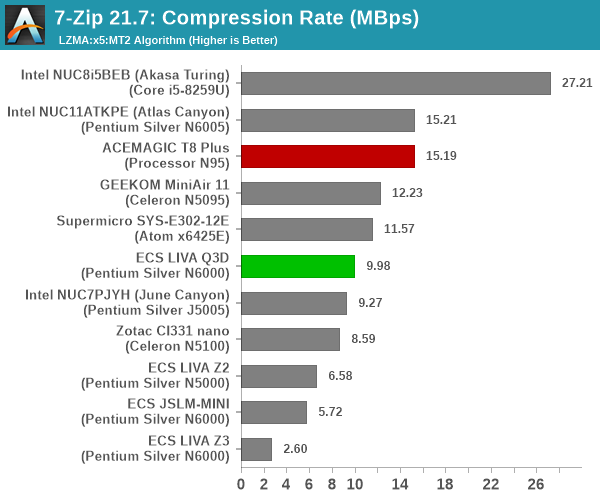
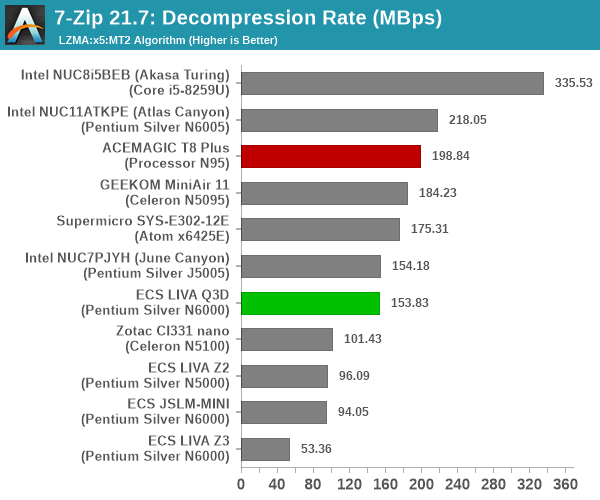
While the ADL-N in T8 Plus manages to handily best the LIVA Q3D's Jasper Lake, the Atlas Canyon NUC with a souped up Jasper Lake processor (PL2 at 25W) enjoys a slight edge over the T8 Plus.
Web Browsing: JetStream, Speedometer, and Principled Technologies WebXPRT4
Web browser-based workloads have emerged as a major component of the typical home and business PC usage scenarios. For headless systems, many applications based on JavaScript are becoming relevant too. In order to evaluate systems for their JavaScript execution efficiency, we are carrying over the browser-focused benchmarks from the WebKit developers used in our notebook reviews. Hosted at BrowserBench, JetStream 2.0 benchmarks JavaScript and WebAssembly performance, while Speedometer measures web application responsiveness.
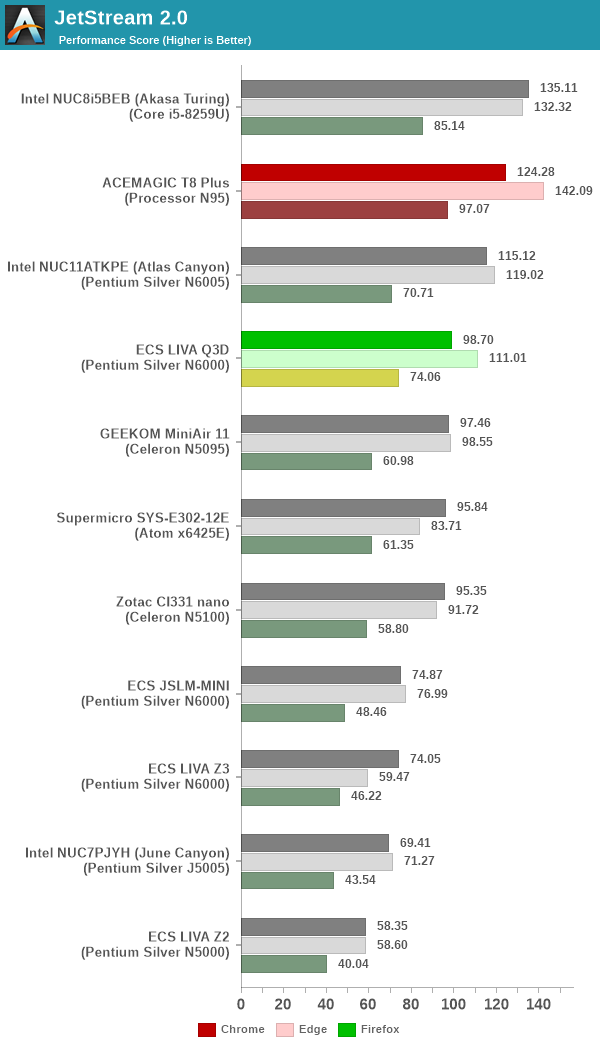
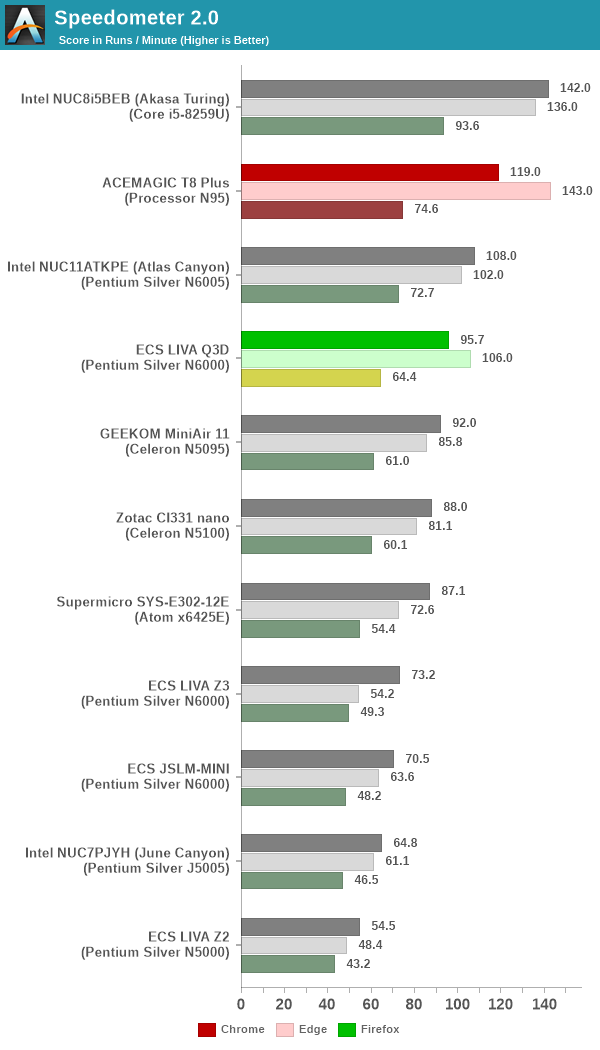
From a real-life workload perspective, we also process WebXPRT4 from Principled Technologies. WebXPRT4 benchmarks the performance of some popular JavaScript libraries that are widely used in websites.
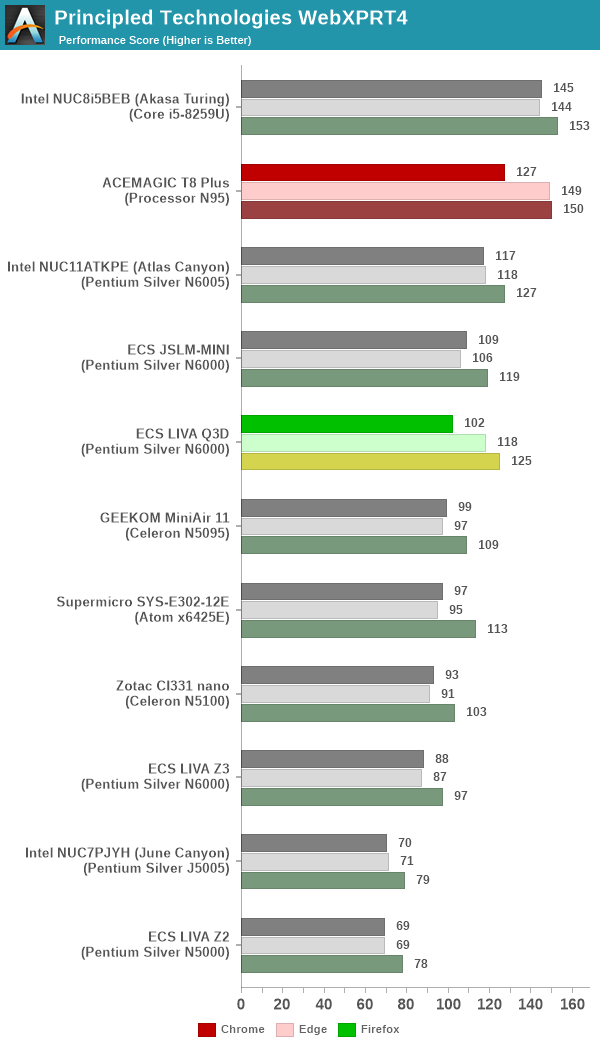
As expected from previous benchmarks, the T8 Plus has the edge over the LIVA Q3D. The surprise here is that ADL-N is almost as good as CFL-U with a much higher power budget in the passively-cooled Bean Canyon NUC.
Application Startup: GIMP 2.10.30
A new addition to our systems test suite is AppTimer - a benchmark that loads up a program and determines how long it takes for it to accept user inputs. We use GIMP 2.10.30 with a 50MB multi-layered xcf file as input. What we test here is the first run as well as the cached run - normally on the first time a user loads the GIMP package from a fresh install, the system has to configure a few dozen files that remain optimized on subsequent opening. For our test we delete those configured optimized files in order to force a ???fresh load??? every second time the software is run.
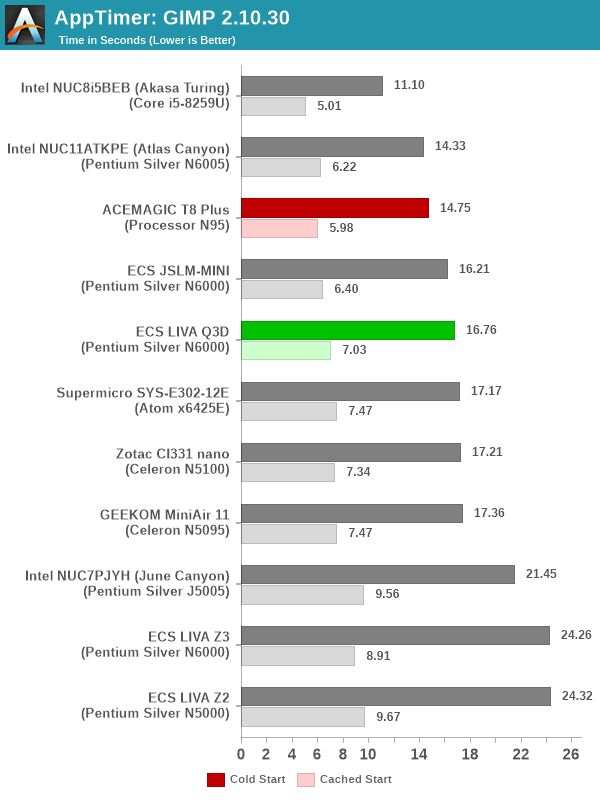
As it turns out, GIMP does optimizations for every CPU thread in the system, which requires that higher thread-count processors take a lot longer to run. So the test runs quick on systems with fewer threads, however fast cores are also needed. Coffee Lake-U has a significant advantage here. The Gracemont cores in the T8 Plus do a creditable job and make the system perform as well as the Atlas Canyon NUC despite the latter's higher PL2 settings.
Cryptography Benchmarks
Cryptography has become an indispensable part of our interaction with computing systems. Almost all modern systems have some sort of hardware-acceleration for making cryptographic operations faster and more power efficient. In the case of IoT servers, many applications - including web server functionality and VPN - need cryptography acceleration.
BitLocker is a Windows features that encrypts entire disk volumes. While drives that offer encryption capabilities are dealt with using that feature, most legacy systems and external drives have to use the host system implementation. Windows has no direct benchmark for BitLocker. However, we cooked up a BitLocker operation sequence to determine the adeptness of the system at handling BitLocker operations. We start off with a 4.5GB RAM drive in which a 4GB VHD (virtual hard disk) is created. This VHD is then mounted, and BitLocker is enabled on the volume. Once the BitLocker encryption process gets done, BitLocker is disabled. This triggers a decryption process. The times taken to complete the encryption and decryption are recorded. This process is repeated 25 times, and the average of the last 20 iterations is graphed below.

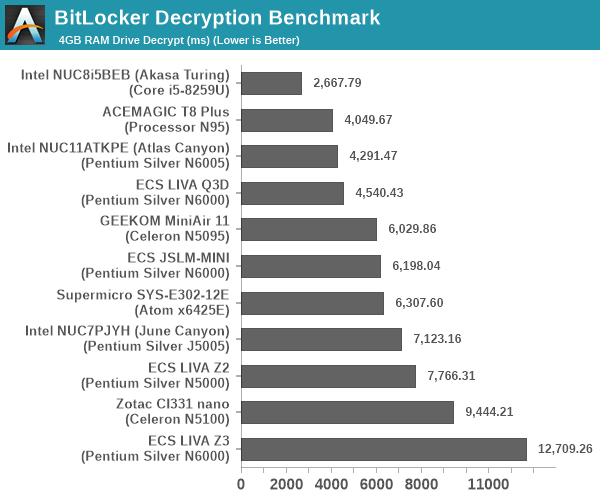
Hardware acceleration is available for the operations in all of the systems. The time taken for processing is directly dependent on the available power budget.










8 Comments
View All Comments
ballsystemlord - Thursday, September 21, 2023 - link
@Ganesh , Your pricing info makes it appear as though the coupon itself saves us $177. Please consider removing the "-" (minus) sign, use a comma or a semicolon instead.Samus - Thursday, September 21, 2023 - link
I'm just waiting for someone to chime in about how the Apple M2 is so much faster... XDballsystemlord - Friday, September 22, 2023 - link
Well, we can't disappoint you so...meacupla - Friday, September 22, 2023 - link
I too have never seen that SSD controller/nand maker.HGO? HSO?
That logo looks too similar to HOS from Patlabor
mode_13h - Monday, October 2, 2023 - link
Except that Labors, like Chobits, clearly had hard disks.sjkpublic@gmail.com - Friday, September 22, 2023 - link
Missing a proper NVME connection / controller? Looks like fastest disk speed is 600 MB/s.t.s - Sunday, September 24, 2023 - link
Thanks for the review.From the idle power side, it's quite high, cause my HP elitedesk 800 G4 65 watt can go as low as < 4W with i5-8500T. Asrock Deskmini x300 with ryzen 5700G is about ~12w idle. All measured from the wall.
mode_13h - Monday, October 2, 2023 - link
Let me know when there's a reasonably-priced (i.e. not industrial) Alder Lake-N mini-ITX board with DDR5 support. So far, I've yet to find one.